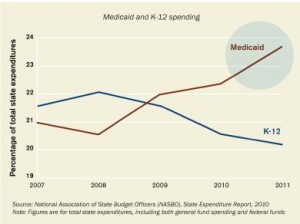Budget analysts have warned for years that state Medicaid spending eventually would grow so big that it would crowd out other budget priorities such as K-12 education. They don’t need to sound the warning anymore. That day is here. Unfortunately, the crowding out will get worse.
As the authors of the “Report of the State Budget Crisis Task Force” state forcefully, when Medicaid was only a small part of state spending, the states were able to fund its fast-growing budget. “But Medicaid is now such a large part of state spending — 24 percent of total funds and 16 percent of state general funds — that the imbalance (or structural budget gap) can no longer be absorbed without significant cuts to other essential state programs like education or unpopular tax increases or both.”
The spending increases are unavoidable, first, because health care costs will continue to increase faster than the general inflation rate, and, second, because the Affordable Care Act (also known as Obamacare) has mandated a huge expansion of the program to households above the poverty line. The latest official estimate is that total Medicaid spending in the decade of 2011-2010 would increase 6.6 percent yearly without the Medicaid expansion and 8.1 percent yearly with it. While state governments will be obligated to pick up only 10% of the ongoing cost of the expanded program after a phase-in period, many are worried that even a modest additional state obligation will be a budget killer.
Regarding Virginia specifically, the study states:
Virginia’s Medicaid program is conservative regarding eligibility, basically limiting coverage to the minimum federal requirements. As a result, the state ranks 48th in Medicaid enrollees as percentage of the state population, at 11 percent. However, optional benefits to enrollees are quite generous; 62 percent of the Medicaid spending in the state is for optional services, above the national average of 60 percent. Also, payment rates to providers are unusually high – 90 percent of Medicare’s rates, compared with a national average of 72 percent. As a result, the average cost per enrollee in Virginia, $5,758, is higher than the national average and higher than that of California, Texas, or Illinois though lower than that of New Jersey or New York.
Unlike many other states experiencing fiscal pressures in recent years, Virginia has not attempted to reduce rising costs by eliminating optional benefits and services. However, it has implemented several provider-based cost saving policies, freezing or reducing various components of delivery and expanding managed care. The most recent biennial budget proposed by Virginia Governor Robert McDonnell includes proposed Medicaid savings of $260 million in fiscal year 2013 and $438 million in fiscal year 2014. If achieved, these proposals would reduce Medicaid costs by three percent in 2013 and five percent in 2014.
Bottom line for Virginia: Because our eligibility requirements are already so close to the federal minimum, we have no leeway to cut spending by rolling back the enrollments. Budget crafters do have some room to reduce optional benefits and squeeze providers but such cuts would meet massive political resistance.
Virginia is experimenting with controlling costs by better managing care, a potentially win-win proposition. It remains to be seen, however, if the anticipated savings actually materialize. In the long run, the only hope for restraining Medicaid spending is to orchestrate a productivity- and innovation-driven health-care revolution in which providers deliver more value (superior medical outcomes at lower costs). No such revolution is in the offing, although there are hints that a private-sector driven health care evolution may be taking place. I am dubious, however, that those improvements can deliver results big enough and fast enough to make a difference to state budgeteers.
— JAB
Special thanks to injury lawyer Thomas Soldan for his support of Bacon’s Rebellion.



